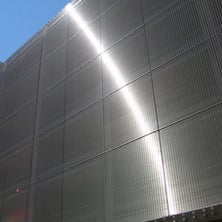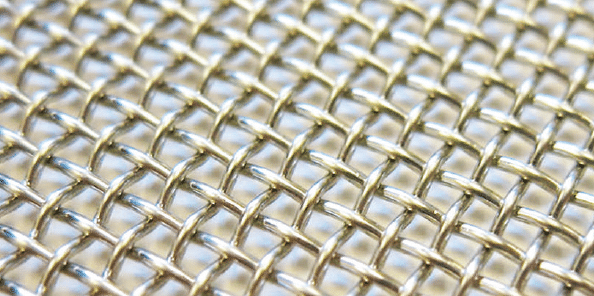Architectural Mesh Alloys: 300 Series Stainless Steel vs 400 Series
Stainless steel architectural mesh delivered the aesthetics and durability that allow architects to turn their vision into a reality. With over 40 different mesh profiles and patterns to choose from, the only true limitation to architectural mesh is your imagination.
That said, to ensure your architectural mesh panels stand the test of time, it is vital that you use the best possible alloy. In the world of architectural design, this generally comes down to two options: 300 series and 400 series stainless steel.
So, what’s the difference between the two?
For over 20 years, W.S. Tyler has helped hundreds of architects employ architectural mesh of various alloys and is here to help you make the most out of your design process.
With that, this article will cover:
- What stainless steel is
- What 300 series stainless is
- What 400 series stainless is
- How 300 series and 400 series compare
- Which alloy may be right for you
What Is Stainless Steel?
 In the world of architectural design, stainless steel is best described as a steel alloy that features characteristics that make it highly resistant to severe corrosive and temperature conditions. As it has become one of the most versatile design materials in the industry, various types of stainless steel are available.
In the world of architectural design, stainless steel is best described as a steel alloy that features characteristics that make it highly resistant to severe corrosive and temperature conditions. As it has become one of the most versatile design materials in the industry, various types of stainless steel are available.
That said, the main differentiating factor between the various stainless steel alloys is their overall quality and level of carbon present.
For a steel alloy to be considered stainless, .1% to .2% carbon must be present, and the level of chromium contents must exceed 12%. Now, chromium is generally not present in steel alloys, so it must be artificially infused while steel is in a molten state.
When it comes to architectural metal mesh, 300 series stainless is the predominant alloy used; however, 400 series can be used for more demanding applications. We will now take an in-depth look into how 300 series and 400 series stainless steel differ.
What Is 300 Series Stainless Steel?
The 300 series stainless steel family is comprised of 9 various alloys. This includes 304, 309, 310, 316, 317, 318, 321, 330, 347.
Despite the many options, 304 and 316 stainless steel are the preferred alloys when constructing metal mesh facades. If your particular architectural design process has special conditions, the other 300 series alloys may be a plausible solution.
With that, 304 stainless steel contains 18% chromium and 8% nickel, while 316 stainless steel contains 16% chromium, 10% nickel, and 2% molybdenum.
NOTE: The inclusions of molybdenum makes 316 a higher quality alloy than 304
What Is 400 Series Stainless Steel?
When it comes to constructing architectural metal mesh systems, the term 400 series typically refers to 430 stainless steel. This particular alloy is made up of 11% chromium and 1% manganese.
Now all 400 series alloys have a higher presence of carbon than 300 series alloys. This makes 400 series stainless steel ideal for high traffic applications as it is more sturdy and durable.
How To Tell Between 300 and 400 Series Stainless Steel?
When comparing 300 series to 400 series stainless steel, the nickel content is the most significant difference. The omission of nickel is a fundamental characteristic of 400 series alloys.
That said, the absence of nickel makes 400 series susceptible to corrosion, more so than 300 series alloys. However, no matter what stainless steel alloy you use, some corrosion resistance can be expected.
An additional essential factor that differentiates 300 series from 400 series alloys is that 400 series stainless steel alloys are magnetic.
Now, when looking at how 300 and 400 series compare in price, 300 series stainless steel is generally more expensive than 400 series. The price difference derives from the corrosion-resistant characteristics that 300 series alloys have the 400 series alloys don’t.
Which Alloy Should I Use?
 The elements and applications your architectural mesh will be subjected to will ultimately determine what alloy you should employ.
The elements and applications your architectural mesh will be subjected to will ultimately determine what alloy you should employ.
For example, suppose your architectural mesh system will be installed in close proximity to an indoor pool or oceanfront. In that case, a 300 series alloy should be used as the chemical used to treat the pool and airborne sea salt may compromise the quality of other alloys.
That said, if you are installing an architectural mesh system away from corrosive elements and in area where visitors come into contact with it, you will want an alloy that delivers maximum durability to exceed safety regulations. For this, 400 series stainless steel is the ideal alloy.
Review the following articles to learn more about how architectural mesh can be applied:
Perfect Your Architectural Mesh Project
Stainless steel allows architectural metal mesh to serve as an aesthetically pleasing and durable design material that delivers a one-of-a-kind atmosphere. That said, delivering an awe-inspiring project starts with deciding whether 300 series or 400 series stainless steel should be used to construct your mesh panels.
When determining which alloy to use, it is important to note that the level of nickel present is the most significant difference between 300 series and 400 series alloys. Once this is decided, your next obstacle is decided what finish will best illustrate your vision.
Having worked within the world of architectural design for over 20 years, W.S. Tyler is here to ensure your design delivers.
To learn more about the finishes you can apply to architectural mesh panels, review our article: Etching vs. Painting Architectural Wire Mesh: What’s Best For My Project?
About Ronnie Brown
Ronnie is the Content Writer for W.S. Tyler and has four years of experience as a professional writer. He strives to expand his knowledge on all things particle analysis and woven wire mesh to leverage his exceptional writing and graphic design skills, creating a one-of-a-kind experience for customers.




